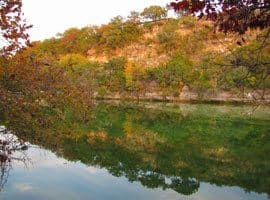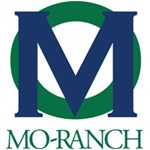About Mo-Ranch
Mo-Ranch is located on the Edwards Plateau, an area that was once an ocean floor. The limestone hills and valleys were formed over millennia by the action of water on the fossil-filled rock. Archeological evidence of human inhabitants dates back about 6,000 years. Nomadic tribes came together in the river valley when local vegetation was ready for harvesting. They cooked, made tools and weapons, and interacted. We know of this activity from the burned ground where they prepared their food, and surrounding “middens”—literally deposits of their trash which include arrowheads and stone tools—and simple pictographs on cliff walls. We are not sure what the drawings indicate, but attempting to record or make sense of the creation in which they existed is a possibility.
Over the centuries these nomadic people were succeeded by Native American tribes with which we are more familiar, such as the Apache, Kiowa and Comanche. No permanent towns or villages were located in the area until the mid-1800s, when Kerrville and Fredericksburg were settled. The land at the headwaters of the Guadalupe in western Kerr County, owned by the Real and then Wilson families, was mainly used for grazing cattle, sheep and goats.
Texas’ booming oil and gas industry of the early 1900s created a new class of businessmen, mostly living in the Houston area. Successful oil and gas magnates looked to the higher and cooler Hill Country as a place to get their families away from the coastal plain’s summer heat and mosquitos. One of these, Odie R. Seagraves, bought 6,500 acres of what is now Mo-Ranch in 1929. The Manor House was constructed for him and his family, and he had the river dammed to make a small lake for recreation, and a landing strip cleared for his private plane. Seagraves grand plans for the ranch soon faded, as he lost a fortune in the stock market crash of 1929. He was able to regain the house and other improvements on 20 acres, but lost most of the land.
Seagraves sold the ranch in 1936 to another Houston oilman, Daniel J. Moran, the president of Continental Oil Co (Conoco). Moran also bought the land Seagraves had lost and ended up with a ranch of about 6,800 acres. He named his estate “Mo-Ranch” and proceeded on a building campaign that created a self-sustaining village—including ice house and power station. An engineer by training, Moran designed impressive buildings, primarily from Hill Country limestone and oilfield pipe—materials easily accessible to him. The Main Auditorium, Guest Lodge, Chapel, Loma Linda Lodge, River Dorm, and Catwalk—and a host of smaller buildings supporting ranching activities—were built under his supervision and often with his direct involvement.
Distinctive, hand-painted San Jose tiles from San Antonio and intricate ironwork by German-born Erich Riesel add rich detail to Moran’s structures. A large swimming pool lined with 2 million tiles was built beside the Manor House on the bluff overlooking the river. Entertainment and hospitality were a hallmarks of Moran’s efforts. The Main Auditorium was designed for roller skating, basketball and showing movies. The Guest Lodge was built for the comfort of his family and Conoco supervisors who concluded lengthy tours of company facilities with stays at the ranch. And the river slide, still a favorite with guests seven decades after its installation, is purely for fun.
Moran died in 1948 at age 59 from a brain tumor, and his widow, Marie, sold the ranch to the Presbyterian Synod of Texas for $512,500, which needed a successor to its outgrown facility at Westminster Encampment in Kerrville. It was a leap of faith for the Presbyterians. Inspired by the Rev. R. Matthew Lynn, a pastor from Midland who would eventually be elected moderator of the denomination, and led by respected churchmen like the Rev. Charles L. King of Houston, Texas Presbyterians approved the purchase, then completed a highly successful fundraising effort to pay for the ranch. The following year, 6,500 acres were sold to the State of Texas and became the Kerr Wildlife Management Area. Over the years adjoining tracts were bought by Presbyterian Mo-Ranch, bringing the total acreage back up to around 500 acres.
Over the 65 years since the purchase, the managing board of Presbyterian Mo-Ranch Assembly added more structures to Moran’s estate—a dining hall (now the Mabee Registration Building) and Pheasant Run motel facility were built in the 1950s. Three decades later, further growth in guest numbers made it necessary to add the Wynne/Flato Lodges and the King Dining Hall. All additions were designed to fit into the architectural themes set by the ranch’s first owners.
Today, Presbyterian Mo-Ranch Assembly serves more than 34,000 men, women and children each year. As with the first people to come here, they continue to seek spiritual nourishment, fellowship and renewal in this special place on the headwaters of a crystal-clear river.






